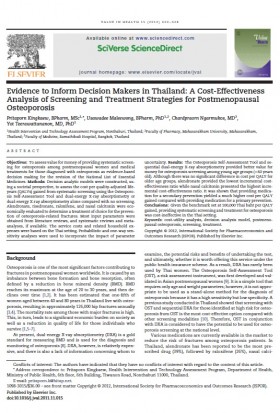This website uses cookies so that we can provide you with the best user experience possible. Cookie information is stored in your browser and performs functions such as recognising you when you return to our website and helping our team to understand which sections of the website you find most interesting and useful.
Evidence to Inform Decision Makers in Thailand: A Cost Effectiveness Analysis of Screening and Treatment Strategies for Postmenopausal Osteoporosis. (2012)

รายละเอียดเพิ่มเติม
Evidence to Inform Decision Makers in Thailand: A Cost-Effectiveness Analysis of Screening and Treatment Strategies for Postmenopausal Osteoporosis.
Pritaporn Kingkaew, BPharm, MSccorrespondenceemail, Usawadee Maleewong, BPharm, PhD, Chardpraorn Ngarmukos, MD, Yot Teerawattananon, MD, PhD
Abstract
Objectives
To assess value for money of providing systematic screening for osteoporosis among postmenopausal women and medical treatments for those diagnosed with osteoporosis as evidence-based decision making for the revision of the National List of Essential Medicines.
Methods
Decision analytic models were constructed, using a societal perspective, to assess the cost per quality-adjusted life-years (QALYs) gained from systematic screening using the Osteoporosis Self-Assessment Tool and dual-energy X-ray absorptiometry or dual-energy X-ray absorptiometry alone compared with no screening. Alendronate, risedronate, raloxifene, and nasal calcitonin were economically evaluated to determine a treatment of choice for the prevention of osteoporosis-related fractures. Most input parameters were obtained from literature reviews, and systematic reviews and meta-analyses, if available. The service costs and related household expenses were based on the Thai setting. Probabilistic and one-way sensitivity analyses were used to incorporate the impact of parameter uncertainty.
Results
The Osteoporosis Self-Assessment Tool and sequential dual-energy X-ray absorptiometry provided better value for money for osteoporosis screening among young age groups (<60 years old). Although there was no significant difference in cost per QALY for older age groups, alendronate provided the lowest incremental cost-effectiveness ratio while nasal calcitonin presented the highest incremental cost-effectiveness ratio. It was shown that providing medication for a secondary prevention yielded a much higher cost per QALY gained compared with providing medication for a primary prevention.
Conclusions
Given the benchmark set at 100,000 Thai baht per QALY gained, providing systematic screening and treatment for osteoporosis was cost-ineffective in the Thai setting.
Full Text: http://www.valueinhealthjournal.com/article/S1098-3015%2811%2903552-2/abstract




